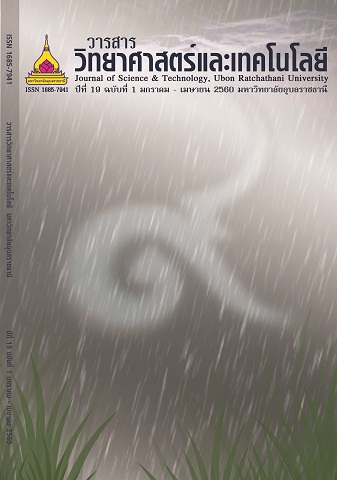The Investigation of xCaO - (50-x)SrO – 50B2O3 Glass Systems Added with CaO from Aassava Rhizome on Elastic and Structural Properties
Main Article Content
บทคัดย่อ
The purpose of this work was to study the elastic moduli and structural properties of xCaO - (50-x)SrO – 50B2O3 glass system (where x was 0, 10, 20, 30, 40 and 50 wt.% of CaO) prepared by rapid quenching technique. In this work, the cassava rhizomes were source of calcium oxide in this glass system. All of glass samples were melted at the temperature 1250 °C for 2 hr and annealed at the temperature 450 °C for 2 hr. The ultrasonic velocities were measured by pulse echo technique at 4 MHz at room temperature. Then, the elastic moduli (longitudinal modulus, shear modulus, bulk modulus, Young’s modulus Poisson's ratio and micro-hardness) and other physical properties such as softening temperature and Debye temperature were calculated. The results showed that the elastic moduli and the physical properties depended on mass percentage of CaO in glass system. This related to the number of bridging oxygen (BO) and non-bridging oxygen (NBO), which could be confirmed by the results of IR spectra.
การศึกษาแก้วระบบ xCaO - (50-x)SrO – 50B2O3 ด้วยแคลเซียมออกไซด์จากเหง้ามันสำปะหลังที่มีผลต่อสมบัติความยืดหยุ่นและสมบัติทางโครงสร้าง
วัตถุประสงค์ของงานวิจัยนี้คือศึกษาสมบัติความยืดหยุ่นและศึกษาโครงสร้างของแก้วระบบ xCaO - (50-x) SrO – 50B2O3 โดยที่ x คือ 0 10 20 30 40 และ 50 wt.% ซึ่งในงานวิจัยนี้แคลเซียมออกไซด์ได้มาจากเหง้ามันสำปะหลัง ตัวอย่างแก้วหลอมที่อุณหภูมิ 1250 °C เป็นเวลา 2 ชั่วโมงและอบคลายความเค้นที่อุณหภูมิ 450 °C เป็นเวลา 2 ชั่วโมง จากนั้นใช้เทคนิคการสะท้อนคลื่นเสียงอัลตร้าโซนิก (Pulse echo) วัดความเร็วคลื่นเสียงอัลตร้าโซนิกที่ความถี่ 4 MHz ณ อุณหภูมิห้อง ตลอดจนศึกษาสมบัติความยืดหยุ่น เช่น โมดูลัสตามยาว โมดูลัสเฉือน บัลก์โมดูลัส ยังโมดูลัส อัตราส่วนปัวซอง และความแข็งระดับไมโคร รวมไปถึงสมบัติทางกายภาพ เช่น อุณหภูมิการอ่อนตัว และ อุณหภูมิเดอบาย พบว่าผลที่ได้จากสมบัติความยืดหยุ่น และ สมบัติทางกายภาพ จะขึ้นอยู่กับเปอร์เซ็นต์ของแคลเซียมออกไซด์ต่อน้ำหนักในแก้วระบบ ซึ่งสัมพันธ์กับจำนวน bridging oxygen (BO) และ non-bridging oxygen (NBO) และสามารถยืนยันด้วยสเปกตรัมอินฟราเรด
Article Details
บทความที่ได้รับการตีพิมพ์เป็นลิขสิทธิ์ของ วารสารวิทยาศาสตร์และเทคโนโลยี มหาวิทยาลัยอุบลราชธานี
ข้อความที่ปรากฏในบทความแต่ละเรื่องในวารสารวิชาการเล่มนี้เป็นความคิดเห็นส่วนตัวของผู้เขียนแต่ละท่านไม่เกี่ยวข้องกับมหาวิทยาลัยอุบลราชธานี และคณาจารย์ท่านอื่นๆในมหาวิทยาลัยฯ แต่อย่างใด ความรับผิดชอบองค์ประกอบทั้งหมดของบทความแต่ละเรื่องเป็นของผู้เขียนแต่ละท่าน หากมีความผิดพลาดใดๆ ผู้เขียนแต่ละท่านจะรับผิดชอบบทความของตนเองแต่ผู้เดียว


